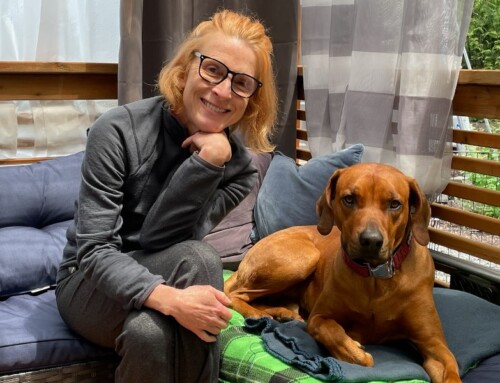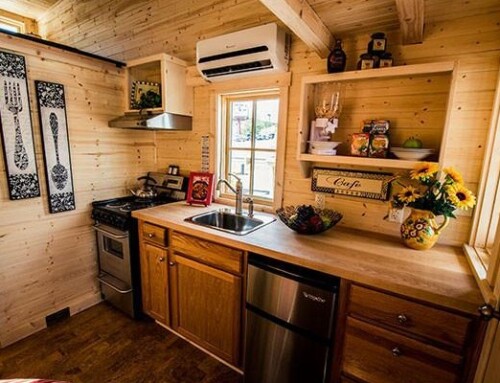Kristin is a Tumbleweed customer and works from her Tiny House RV. With so many people now working from home and considering a tiny house office, we asked her to share her experience.
By Kristin Noreen:
Adapting to a Tiny Office
My friends think I’m crazy, working in a 32-square-foot office. If you’ve ever worked in a cubicle in a big city office, a tiny house office isn’t that big a leap. It’s the same size space, but without people leaning their elbows on your cube wall and having noisy conversations in the aisle. I’ve been working remotely for 12 years now – the last 3 in my Tumbleweed Tiny House RV.
Overcoming Remote Work Challenges
Yes, there are challenges to permanent remote work. Communication with the boss can be a problem, especially if your boss is not a good delegator on the best of days. If you work as part of a project team, you may find yourself serving as the communication hub, whether or not that’s your job. If you need specialized equipment, like a high-speed printer or a large-format plotter, you may need to use outside services like FedEx Office or their local competitors.
The Perks of a Tiny House Office
But the advantages! Your kitchen is right there, along with your favorite chair, for break time. You have full control of the coffee machine—no one else can take the last cup and not make more. You can run an errand and not even have to tell anyone you’re out, much less explain your absence. Freedom from micromanaging is instantly addictive.
I spent my first 9 years of telecommuting in a 2-bedroom condo. The second bedroom was my office. The only part of the room I really used for work was the computer desk. The rest of the room had my guest bed and storage for the mountains of stuff that naturally accumulate in such a space.

Embracing the Realities of a Tiny House Office
Stuff accumulates in a tiny house too, and the office is no exception. I had planned to clean my office to a pristine, sparkling state for these photos. Then I remembered how much I hate those tiny house photos of spare, perfectly staged spaces with lots of healthy house plants (please!). I really work in this office, and it looks like it. The random stacks of paper stay; my computer stays on the cardboard box I use to boost the monitor to a comfortable height. My plastic utility drawers will stay bulging with small items carelessly stuffed into them. This is life in a tiny house office, and I wouldn’t have it any other way.
Some things to think about when planning to work in your tiny office:
Internet service—it’s a necessity for remote work. If your tiny house is parked in a consistent location, it’s easy. My internet cable runs in a buried garden hose from the main house to my RV utility pole, then it plugs into the jack on the side of my tiny house. (Tumbleweed tiny houses are internet-ready.) I have a wi-fi modem in my utility closet and I get good signal out in the yard, so going outside to work in summer is an option. If you take your tiny on the road, you might need satellite service, which is more expensive but still widely available. Before you commit to staying in a location for a while, make sure you’ll be able to get adequate signal for the kind of work you do. (Many people can get by with just email; I need high-speed service for the interactive mapping software I use in my work.)
I found the initial wiring-up process with the router and all to be kind of daunting, and an IT-nerd friend organized my wiring into beautiful conduit tracks. (It also reduces fire hazard in the supply closet to have everything all nicely buttoned up like that.) The Tumbleweed USB outlets are a godsend for adapter-free device charging, and I can run USB-powered devices without overloading my computer’s USB ports.
Physical mobility in your chosen workspace—my friends all ask me why I don’t use one of my lofts for my office. Think about it—could you work in a space where you couldn’t stand up, or even sit at a desk in a proper chair? Working in a beanbag chair and scooting around in a low-ceilinged loft wouldn’t work for me. If it would work for you, more power to you, but seriously consider starting with a space you can walk around in.
Shun paper. You don’t have a lot of space; your office needs to be as paperless as you can make it. When mail comes in, handle it on the spot. Scan anything you need to keep, and shred or recycle the original. You can’t let the paper pile up or it will own you. Not long ago, my integrated washer/dryer kicked into the spin cycle and the vibration sent a stack of papers cascading to the floor.
Are you alone there? Many people share tiny houses with a partner or family. Think about who else might be in the house with you. Communicate expectations to others in your space. Do they need to make themselves scarce during your work time? How can they respect your space while they’re around?
Set Your Boundaries—if your tiny house is in a high-activity area like an RV park, and you’re likely to get people coming to your door, make a sign asking for privacy and put it up before your Zoom session or phone call begins. Also be ready to enforce boundaries with friends and family, near and far. Don’t be afraid to send your friends to voice mail. They’ll learn the routine eventually. Your mother never will, but everyone else tends to adapt.
Another note about Zoom—your tiny house as a backdrop tends to be way too interesting to your colleagues. Unless you want to take time from your meeting to lead your team on your own version of Tiny House Tours, consider using a stock photo backdrop.
Working from a tiny house can be incredibly rewarding. For introverts who like to work alone, it’s ideal. You can have music or silence; you can take as many or as few breaks as you need. I love having my cat around while I work. I always wanted to be a stay-at-home cat mom; now I’m doing it and nobody’s laughing. Isn’t that what the tiny house movement is all about—doing it your way?








This informative article is full of good tips as well as entertaining. “Your friends will…learn the routine eventually. Your mother never will but everyone else seems to adapt.” 😂
I hope to see more tiny house-living articles from Kristin Noreen.
Loved this article! You were just setting the office when I visited you. Sounds like everything worked out great.
Is your office space a “stand alone” structure or part of a larger unit?
Bathroom?
Distance from a larger unit with facilities?
Peace,
We’ve built over a dozen tiny house “offices”. Most people get a regular tiny house with bathroom, kitchen, etc. It makes it easier to resell. However, we’ve built offices that are one room, or two offices in the same unit.
Len, it’s part of a 26-foot Elm Overlook floor plan (which can be viewed on the Tumbleweed website). It has a bathroom and upgraded “gourmet” kitchen with induction range. My office is a 32-square-foot room on the main floor that was designed to accommodate a twin-sized bed if desired.
Excellent guide for future reference. Especially regarding fire prevention!!! Thank you
$728/month x 12 months/year x 25 years = almost $230,000
You don’t think that is a bit much for a Tiny House? And what do you have after 25 years? How many Tiny Houses are there that are 25 years old and what are they worth?
Every mortgage for a conventional home works the same way. In most cases it’s less expensive than renting … and in the end it IS paid off.
And not everyone finances that way. I paid $20k down, another $20k upon selling my condo that was barely above water, and I’ve fast-paid on the loan so I expect it to be fully paid off by my 5-year anniversary.